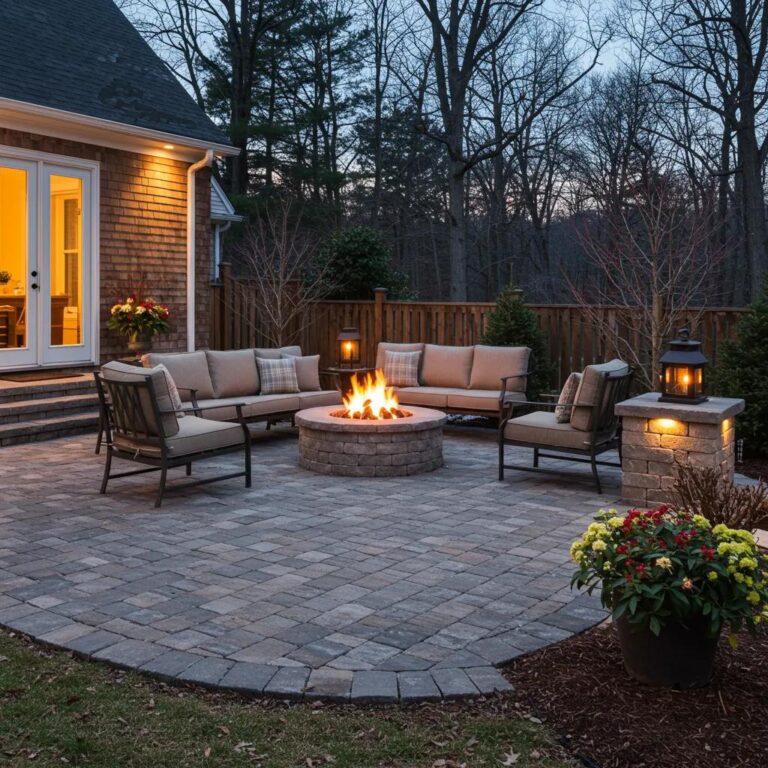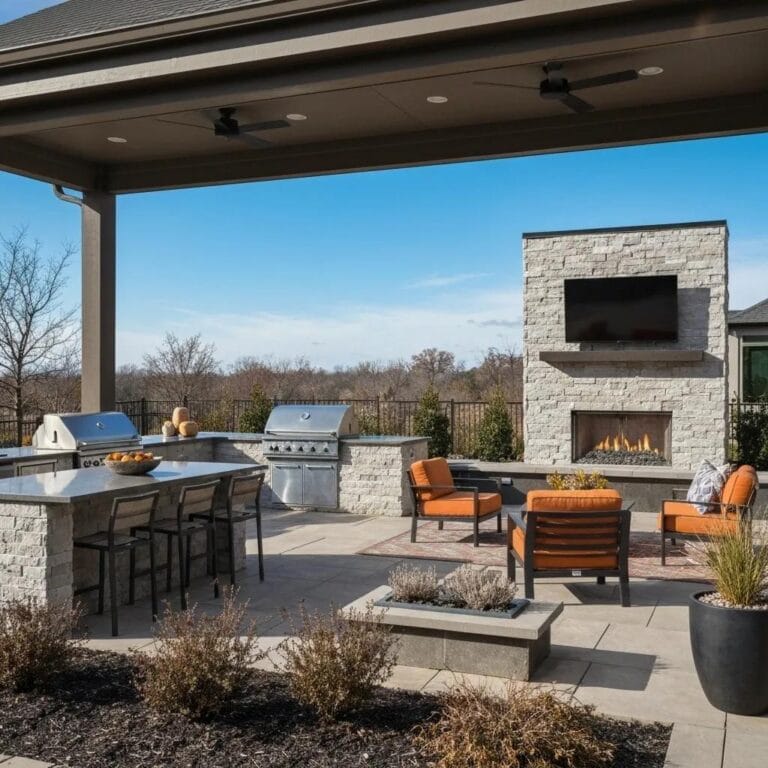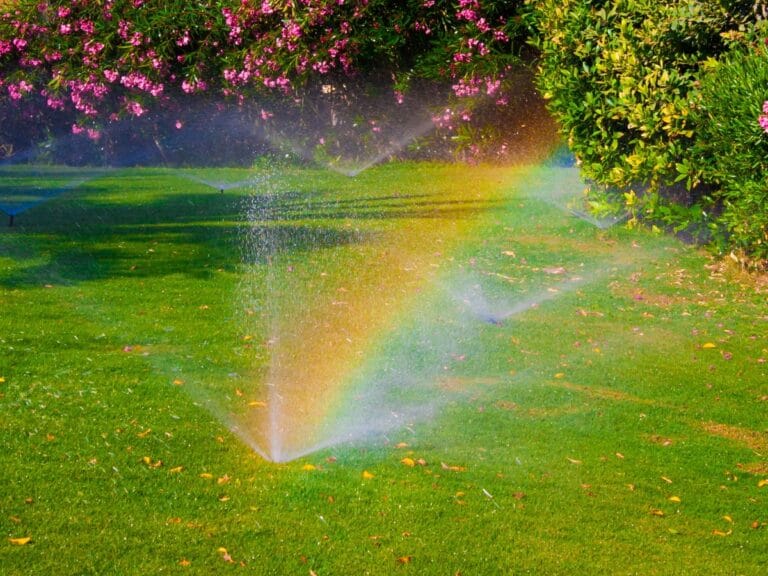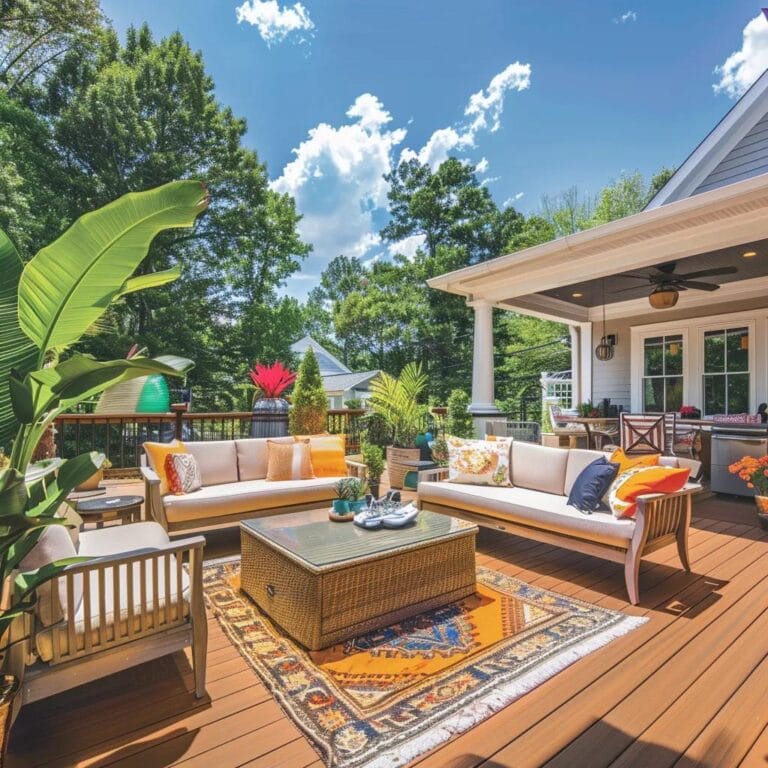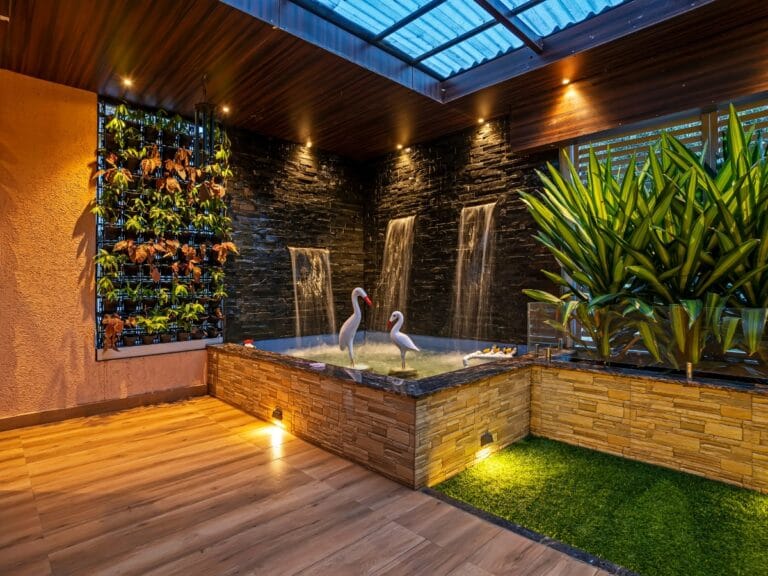Integrating water features in hardscape design is a powerful way to bring movement, tranquility, and sophistication to any landscape design. Whether it’s a sleek fountain embedded into a stone patio or a cascading waterfall flowing alongside a walkway, these features do more than beautify—they elevate the entire outdoor experience. When planned thoughtfully, water and hardscape can work in harmony to create seamless transitions between natural and built environments. In this article, we’ll explore how to strategically incorporate hardscape water features into your landscape, ensuring both visual appeal and functional design.
Add Tranquility to Your Yard with Hardscape Water Features in Landscape Design
What Are HardscapeWater Features and Their Role in LandscapeDesign?
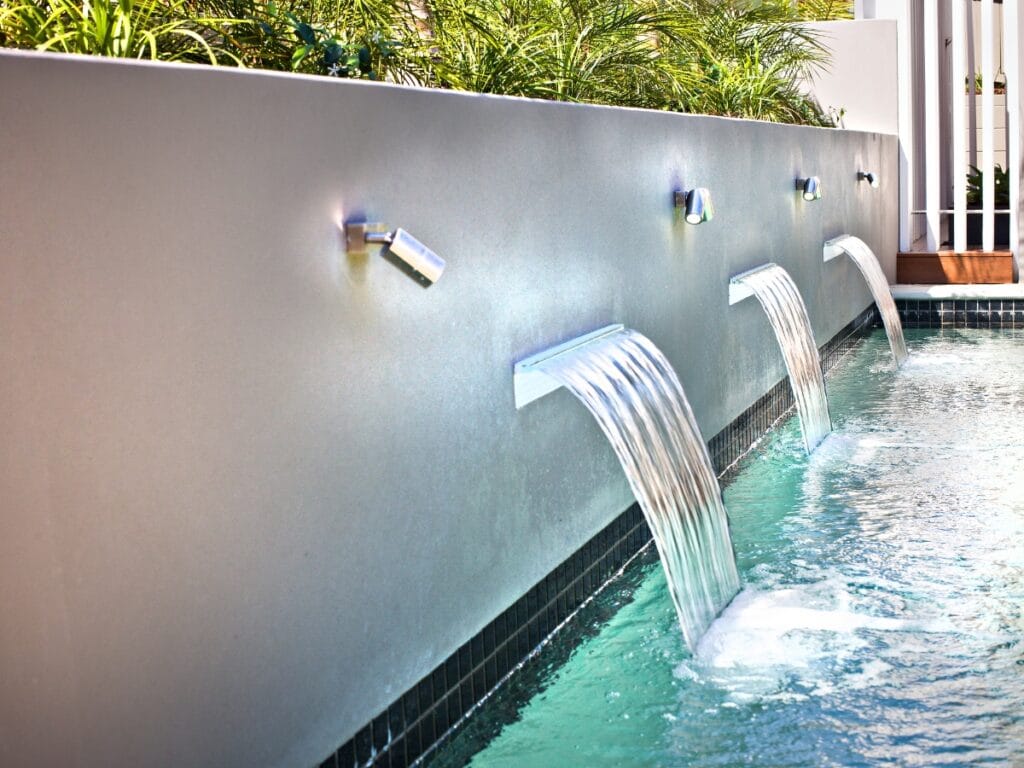
Hardscape water features are engineered installations—ponds, waterfalls, fountains, and water walls—that bring controlled movement and sound into a landscape. Unlike natural bodies of water, these features rely on pumps and plumbing to circulate water over stone, concrete, or metal surfaces. By introducing flowing or still water into patios, gardens, and entryways, they create a sense of calm, help moderate surrounding temperatures, and provide habitat for birds and beneficial insects.
Which Types of HardscapeWater Features Enhance Outdoor Spaces?
Waterfalls can be built into retaining walls or raised planters, where water cascades over stone ledges to mask background noise and soften rigid edges. Ponds, stocked with aquatic plants and ornamental fish, serve as living ecosystems—lilies filter the water while koi and frogs add movement and color. Fountains range from classic tiered bowls to minimalist spouts embedded in courtyards, acting as visual focal points.
Modern designs include vertical water walls, where sheets of water glide down textured panels, and narrow streams that wend through paved areas. Many systems incorporate recirculating pumps and can tie into rainwater harvesting to minimize municipal water use.
How Water Features Elevate Landscape Design
Moving water introduces dynamic texture and sound, breaking the monotony of static paving or planting beds. Reflective surfaces catch sunlight and moonlight, while the gentle patter of water creates a multisensory experience that draws people outdoors. In luxury markets, such features increase curb appeal and help a property stand out.
By combining hard materials—like stone terraces or steel fire pits—with water’s fluidity, designers create balanced outdoor rooms that feel both structured and alive. A well-placed water element can also highlight architectural details, such as framing a garden gate or accenting a pool deck.
How to Plan for Custom HardscapeWater Features in Landscape Design?
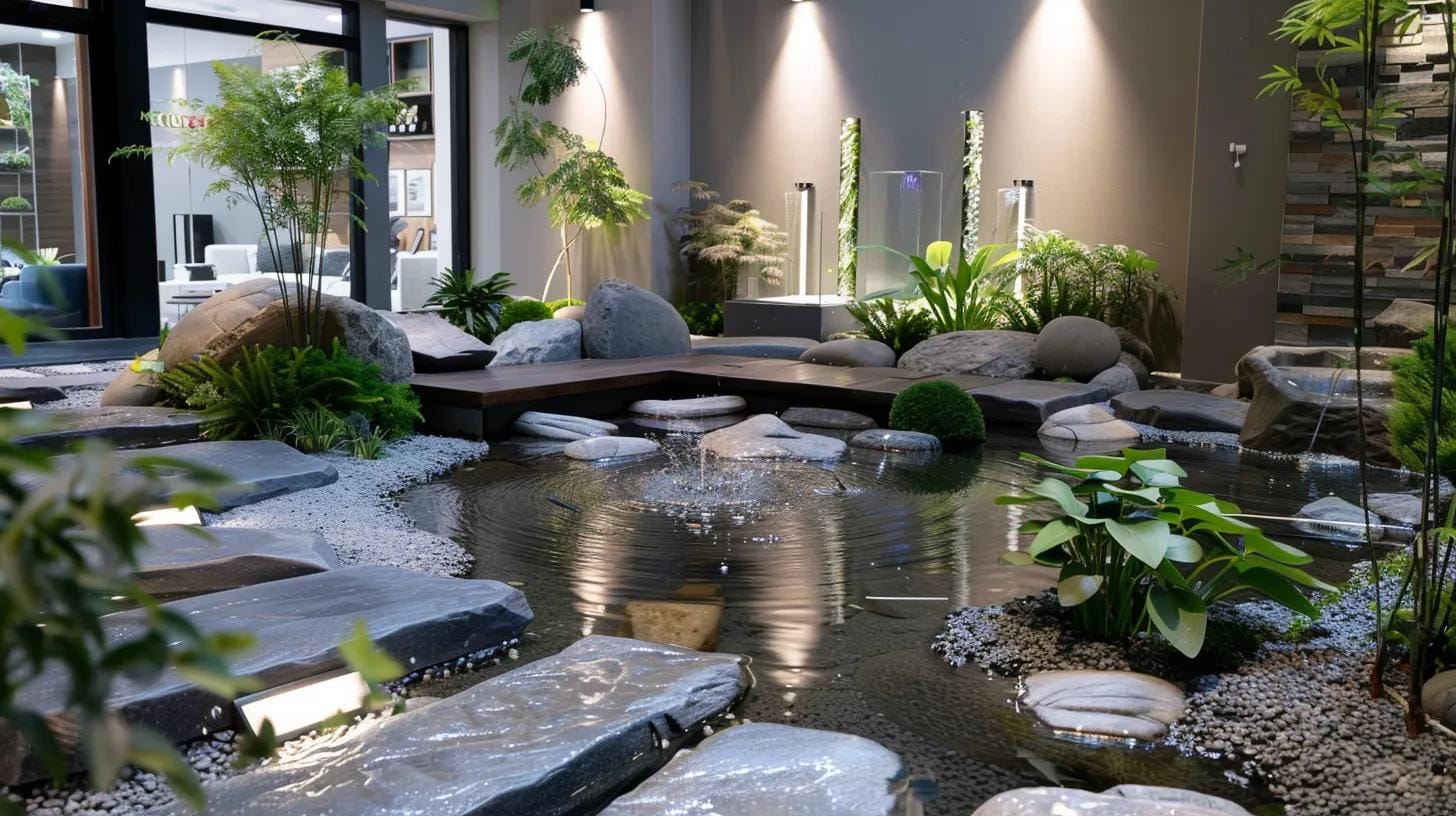
The first step in planning a custom hardscape water feature is examining the site’s conditions. Soil type, drainage patterns, and topography determine where water will collect and how foundations must be built. Existing structures—patios, decks, retaining walls—set the framework for integration, while sun exposure and prevailing winds inform water flow and evaporation. By surveying these factors, designers can position ponds, fountains, or waterfalls in locations that enhance the landscape without causing erosion or standing-water issues.
Balancing Scale and Function
A water feature must fit the proportions of its surroundings. In a small courtyard, a modest bubbler or wall fountain offers visual interest without dominating the space. In a larger garden, a multi-tiered waterfall or expansive pond provides a dramatic focal point. Functional needs—such as recirculation pumps, filtration systems, and access for service—also influence size and layout. Effective design merges these practical requirements with aesthetic goals, ensuring that the feature remains both beautiful and operable throughout its lifetime.
Integrating With Existing Elements
Seamless integration begins by echoing materials and lines already present in the landscape. A modern water wall might mirror the horizontal pattern of a stone patio, while a naturalistic pond blends rock edging and planting beds. Mood boards, 3D renderings, and sample materials help visualize how colors, textures, and lighting will interact. By aligning the feature’s style—whether crisp and contemporary or rustic and organic—with surrounding garden elements, the installation feels intentional, not tacked on.
Selecting Durable Materials and Styles
Durability hinges on choosing materials that withstand local weather. In humid, hot climates like Atlanta’s, concrete products reinforced with polymers resist cracking, while natural stones such as granite or bluestone endure moisture without spalling. Engineered composites can mimic these surfaces with lighter installation weight. Styles range from minimalist water ribbons and geometric spouts to traditional stone troughs and carved basins. LED lighting and energy-efficient pumps add a modern touch and reduce ongoing power use, while solar-powered circulators offer off-grid options.
Professional Installation Process for Hardscape Water Features

Installing a hardscape water feature begins with detailed planning and site preparation. Contractors review blueprints and conduct a thorough on-site analysis to identify grading challenges, utility lines, and drainage patterns. After marking the layout, they excavate the soil to the required depth, then build a reinforced base—often using compacted aggregate or concrete—to support the weight of water and stone. Waterproof liners or membranes follow, creating a watertight shell that prevents leakage. Precise installation of underlayment and protective geotextiles ensures that roots or shifting soil cannot puncture the liner over time.
Ensuring Longevity and Functionality
To guarantee reliable performance, professionals select high-quality pumps, filters, and control systems designed for continuous operation. Pumps are mounted on concrete pads or within insulated vaults to reduce vibration and protect against flooding. Filtration systems—ranging from mechanical skimmers to UV clarifiers—keep water clear and limit algae growth.
Technicians conduct flow-rate and pressure tests, adjusting valves and nozzles until water moves at the intended speed and volume. Electrical wiring runs through weatherproof conduits and connects to GFCI-protected outlets, meeting local codes and ensuring safe operation even in wet conditions.
Equipment and Techniques for Water Walls and Streams
Large-scale installations like water walls require concrete mixers and formwork to create sturdy backings that hold the weight of cascading water. After setting the forms, contractors place rebar reinforcement and pour concrete, then apply waterproof coatings and tile or stone veneers. For artificial streams, trencher machines carve narrow channels while maintaining natural contours.
Subsurface piping is positioned to deliver water along the stream’s length, and recirculation pumps return it to a hidden reservoir. Laser-guided leveling tools help achieve a consistent slope, preventing pools or dry spots, while eco-friendly adhesives and silicone sealants bond stone and prevent future leaks.
Professional Installation’s Impact on Maintenance
A well-executed installation reduces the likelihood of leaks, pump failures, and excessive algae growth. By incorporating easily accessible filter housings and removable pump vaults, technicians make routine inspections and cleaning straightforward. Built-in diagnostic systems can monitor pump performance and water quality, alerting homeowners to issues before they escalate.
Properly sloped surfaces and strategic overflow outlets manage heavy rain, preventing erosion and overflows. Over time, these thoughtful design and construction choices translate into lower maintenance costs, fewer service calls, and a water feature that remains both beautiful and dependable for years to come.
How to Maintain HardscapeWater Features for Optimal Performance and Beauty?
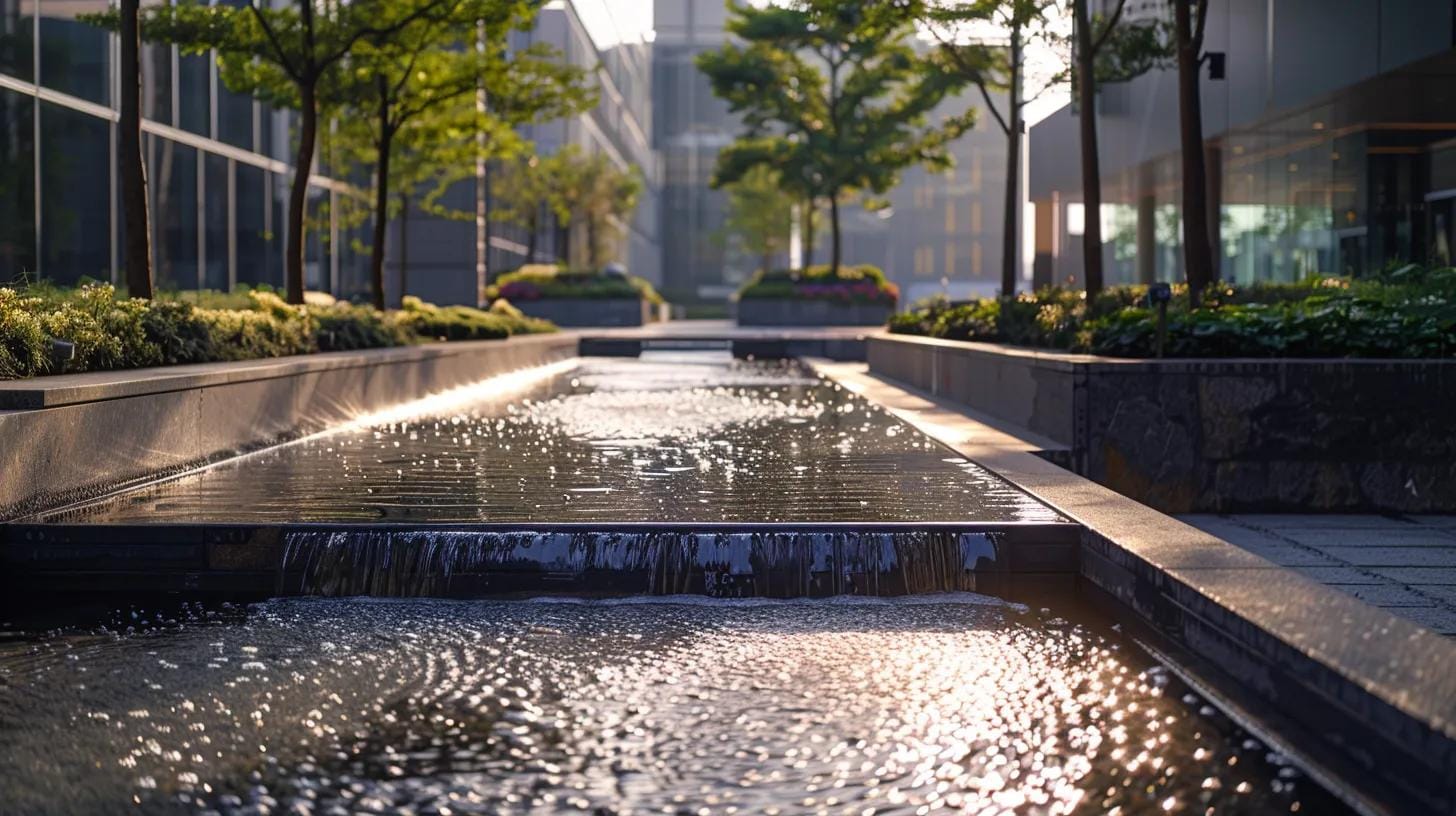
Hardscape water elements—whether a reflecting pool, a cascading waterfall, or a simple fountain—offer a calming focal point and enhance any landscape. To keep your feature running smoothly and looking its best, regular upkeep is essential. Neglect allows debris to collect, pumps to strain, and surfaces to fade. A consistent maintenance routine not only preserves the water feature’s charm but also prevents costly repairs down the road.
What Are the Best Practices for Cleaning and Water Quality Management?
Begin by skimming leaves, sticks and other debris from the water surface at least once a week. Gently scrub pond walls and decorative stones with a soft brush and a mild, non-abrasive cleaner to remove algae without scratching the finish.
A pressure washer can be helpful for hard-to-reach corners, provided you use a low-pressure setting. To keep water clear, install a natural filtration system such as densely planted floating vegetation or bio-filtration units. Adding a small UV sterilizer in the circulation line helps control microscopic algae and bacteria.
Every two weeks, test the pH and clarity: a balanced pH between 7.0 and 7.8 supports pump health and discourages scale or corrosion. If you notice the water turning green or cloudy, perform a partial water change—replacing up to 30 percent at a time—to restore clarity without stressing aquatic life.
How Often Should Maintenance Services Be Scheduled?
Homeowners should set aside time each month for a basic checkup. This involves clearing debris from skimmers, checking that jets and nozzles are free of obstructions, and giving pump housings a quick visual inspection. In addition, arrange for a skilled technician to examine the entire system every three to six months. These deeper inspections focus on pump performance, electrical connections, and the condition of seals and fittings. In regions with heavy pollen, falling leaves, or frequent storms, shorten the interval to every three months. Such proactive attention keeps water circulating efficiently, extends the life of mechanical parts, and preserves the feature’s overall health.
What Are Common Issues and How to Troubleshoot Them?
Algae buildup often follows periods of strong sunlight or nutrient-rich runoff. Adjust the flow rate to increase turnover and add a safe algaecide according to the manufacturer’s instructions. If the pump slows or stops, first turn off power and clear any tangled debris from the impeller. Persistent motor noise or vibration may indicate worn bearings—replacement is usually straightforward.
Clogged filters reduce flow and strain pumps; rinse filter media in a bucket of feature water rather than tap water to protect beneficial bacteria. Mineral deposits can form along waterfalls and spillways; gently scrub these areas with a vinegar solution to dissolve buildup. Finally, uneven water flow or wet spots around the base can signal a hidden leak.
Mark and monitor any damp areas, then apply a suitable sealant or replace damaged lining. Keeping a simple maintenance log—dates, observations, actions taken—makes it easier to spot recurring problems and respond before they worsen.
How Do HardscapeWater Features Increase Property Value and Outdoor Enjoyment?
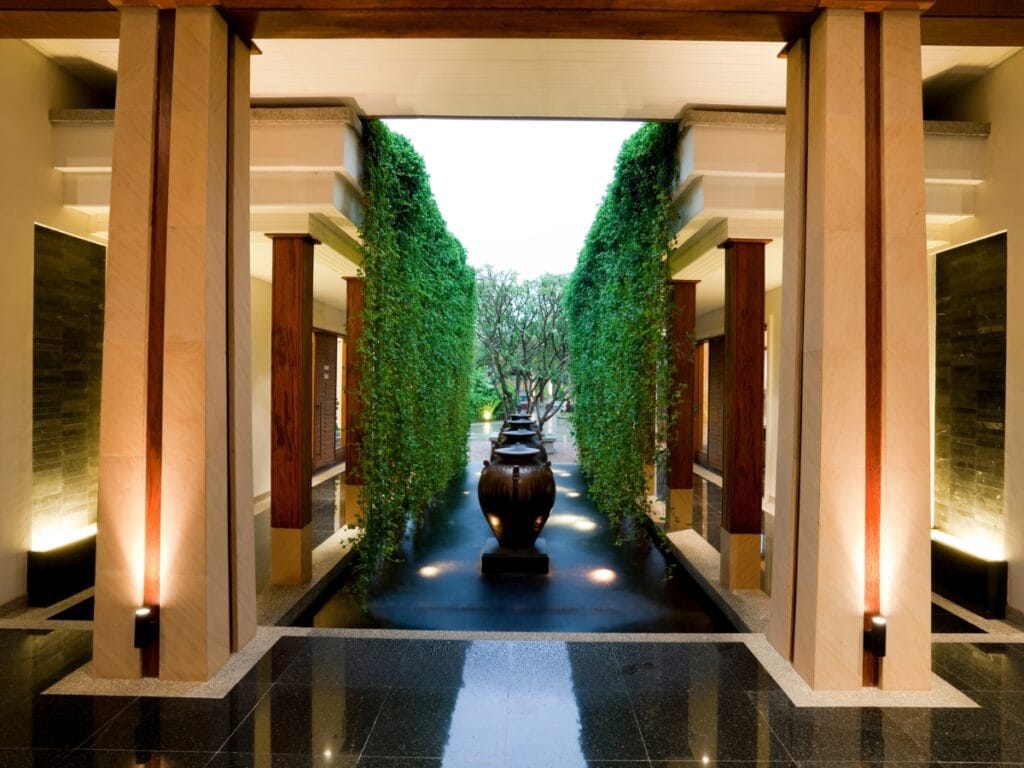
Hardscape water features bring both immediate charm and long-term value to any property. A well-placed fountain, reflecting pool, or waterfall creates a natural focal point that draws the eye and soothes the senses. Beyond their visual appeal, these features signal thoughtful design and attention to detail—qualities that resonate with guests and potential buyers alike.
Boosting Property Appeal and Value
A quality water element can raise curb appeal and support higher resale prices. Realtors report that homes with professionally installed water features often spend less time on the market and command stronger offers. Even a modest pond or bubbling fountain shows that the landscape has been thoughtfully crafted, setting a property apart from the competition. Seasonal lighting and decorative stonework further highlight the water feature, making outdoor spaces feel welcoming from spring through winter.
Aesthetic and Environmental Advantages
Water features add texture and movement to a garden in ways that plants alone cannot. The sight and sound of flowing water mask traffic noise, soften harsh architectural lines, and invite wildlife such as birds and butterflies. Humidification from evaporation helps cool the surrounding air, while planted gravel filters and circulating pumps keep water clear without harsh chemicals. Subtle LED lighting installed around edges or beneath a spillway transforms these features into evening focal points, extending their visual impact long after sunset.
Extending Outdoor Living and Enjoyment
By integrating seating areas, dining nooks, or winding pathways around a water feature, you turn a backyard into a multi-sensory retreat. Morning coffee beside a gentle waterfall can feel like a personal spa, while the same spot becomes an intimate gathering place under softly glowing lights. Homeowners find that friends and family spend more time outside when they can relax to the sound of water and unwind in a setting designed for comfort and conversation.
What Are the Latest Trends and Innovations in HardscapeWater Feature Design?
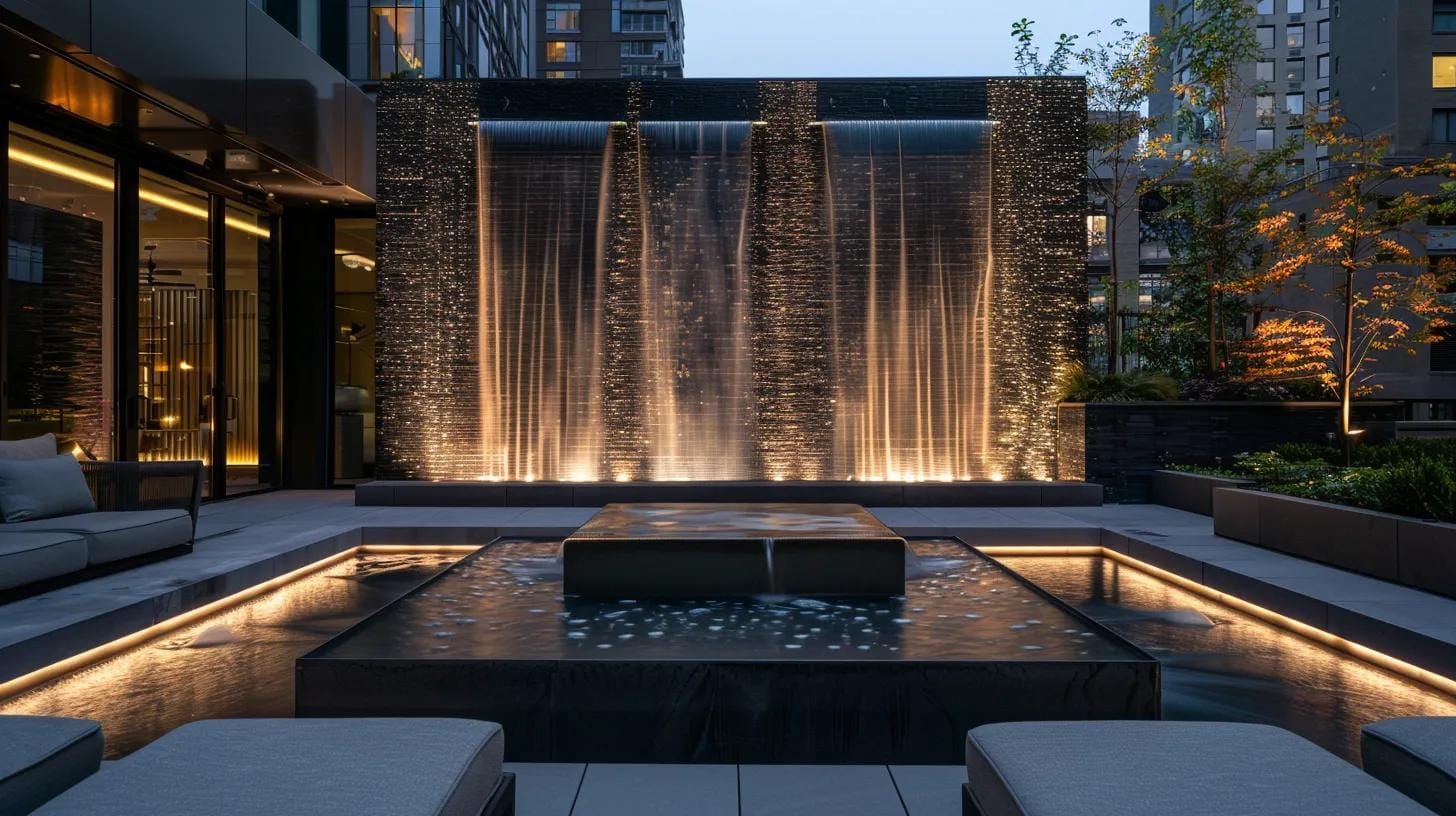
Hardscape water features are embracing smarter, more sustainable approaches without sacrificing style. Designers now rely on automated controls that adjust water flow, lighting and filtration based on real-time conditions. This kind of technology prevents waste and keeps maintenance to a minimum. Sensors can detect water clarity and pH levels, then trigger filtration cycles only when needed.
Programmable LED fixtures respond to daylight and foot traffic, switching on at dusk and dimming when the area is empty. By combining automation with weather-responsive settings, these systems deliver consistent performance while using less power and water.
Smart and Sustainable Designs
Today’s features often include built-in rainwater harvesting or closed-loop recycling systems. Captured runoff settles in underground reservoirs before being reintroduced to fountains or waterfalls. Low-energy pumps move water through natural media filters, such as gravel beds or planted bio-filters, to remove sediments and nutrients without harsh chemicals. In some installations, solar panels supply all of a feature’s electrical needs. All of these elements work together to reduce a project’s carbon footprint and operating costs, while still creating eye-catching focal points.
Water Walls and Eco-Friendly Innovations
Sleek water walls have surged in popularity thanks to their sculptural appeal and compact footprint. These installations often reuse the same body of water, flowing down a flat surface made from recycled glass, weathered steel, or composite stone. Vertical green walls placed behind or alongside the water add texture and support native pollinators.
Subtle uplighting highlights plant textures at night, and gentle mist nozzles keep air cool on warm evenings. By pairing these living elements with simple geometry, designers create striking backdrops that feel both modern and deeply connected to nature.
Advanced Materials and Technologies
Recent breakthroughs in high-performance concrete and molded composites mimic natural rock at a fraction of the weight. These materials resist cracking, staining, and fading, so they look fresh year after year. New filtration media capture micro-particles more efficiently, extending the intervals between cartridge changes.
Pump manufacturers now offer units with variable-speed drives that adjust output to match the feature’s flow requirements, cutting energy use by up to half. IoT-enabled controls can be accessed through smartphone apps, making it easy to monitor system health and schedule maintenance from anywhere.
Choosing the Right LandscapeDesign Company for HardscapeWater Features
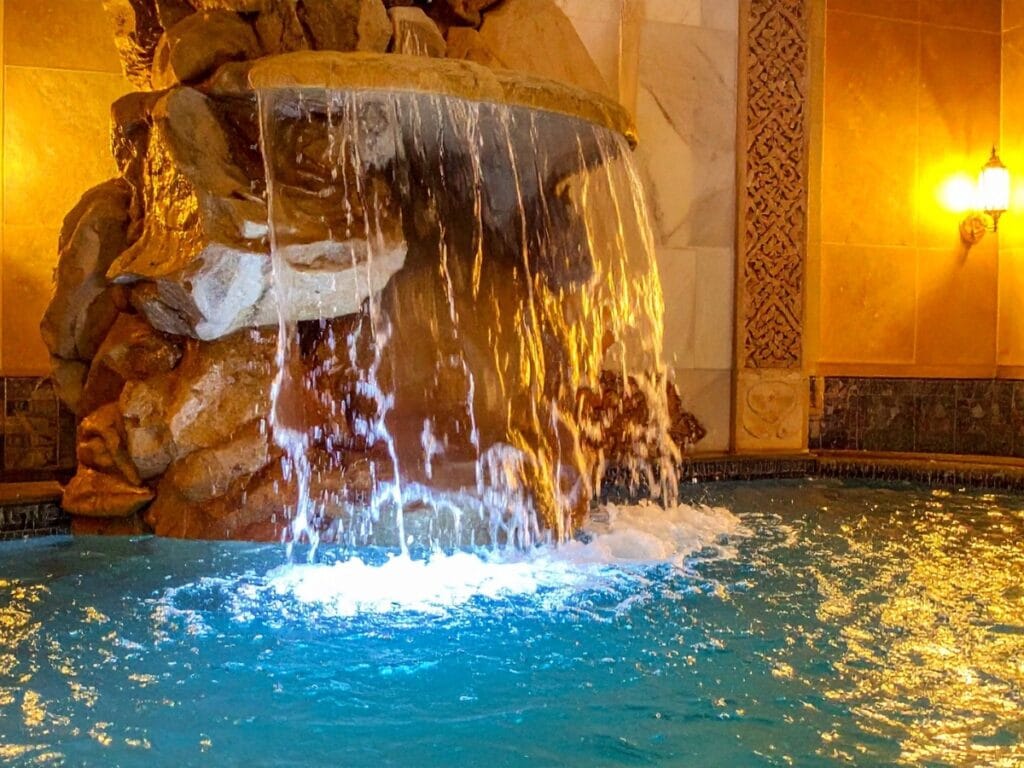
Selecting a firm with the right expertise lays the groundwork for a successful installation. Look for companies that begin with a thorough site evaluation, asking about soil conditions, runoff patterns, and existing plantings. A firm that takes time to understand your goals and budget will tailor its proposal to suit both aesthetic and practical needs. Verify that the team holds appropriate licenses and carries liability insurance. Clear timelines and a detailed contract—outlining deliverables, payment schedules, and warranty terms—help prevent surprises as the project moves forward.
Key Factors to Consider Before Hiring
Experience with hardscape water elements in your region makes a difference. Materials behave differently under local climate conditions, so ask how past projects have held up through seasonal changes. Inquire about the types of stone, concrete or composite materials the company prefers and why. Understanding maintenance requirements ahead of time lets you plan for future care. A skilled landscape partner will offer guidance on energy-efficient pumps, natural filtration methods and lighting options without pushing extra services.
Reviewing Portfolios and Customer Feedback
Inspecting before-and-after photos offers insight into a company’s range and creativity. Look for projects that resemble your vision, whether that’s a minimalist water wall or a layered pond with multiple spillways. Case studies with documented challenges and solutions reveal how the team adapts to obstacles like uneven terrain or tight spaces. Customer testimonials on independent review sites highlight reliability, responsiveness and problem-solving. If possible, visit a completed installation to see workmanship up close and ask the homeowner about their experience.
Benefits of Ongoing Maintenance Agreements
Signing up for a regular upkeep plan safeguards your investment. Routine inspections catch small issues—loose fittings, pump wear, algae buildup—before they become expensive repairs. Professional maintenance often includes seasonal tasks like winterizing lines, testing water quality and adjusting flow rates. Some providers offer remote monitoring that alerts you to power outages or pressure drops. A predictable schedule and fixed monthly fee simplify budgeting and ensure your feature remains both beautiful and functional over the years.
Ensuring Clear Communication and Warranty Terms
A trustworthy company stands behind its work with solid warranties on parts and labor. Before work begins, confirm how long the warranty lasts and what it covers—from pump motors to stone seals. Ask how change orders are handled and who to contact if questions arise during installation. Regular progress updates, whether by email or quick site visits, keep you informed and involved. When communication stays open and expectations are clearly outlined, the entire process becomes smoother and more rewarding for everyone.
Frequently Asked Questions
Q: What exactly are hardscapewaterfeatures? A: They are engineered installations—such as ponds, waterfalls, and fountains—that integrate water into landscape design to enhance aesthetics and provide benefits like noise reduction and increased property value.
Q: How does incorporating a waterfeature increase property value? A: By dramatically improving curb appeal and creating a tranquil, inviting environment. The dynamic visuals and calming sounds contribute to a premium outdoor living experience valued in markets like Atlanta.
Q: What maintenance is required for hardscapewaterfeatures? A: Regular cleaning to remove debris, periodic water quality monitoring, and servicing of pumps and filtration systems. Monthly light maintenance combined with professional inspections every three to six months helps extend the feature’s lifespan.
Q: Are waterfeatures environmentally friendly? A: Yes. Modern water features incorporate technologies such as rainwater harvesting, natural filtration, and energy-efficient pumps to reduce water waste, lower energy use, and support biodiversity.
Q: Can I integrate a waterfeature into my existing landscapedesign? A: Absolutely. Professional designers can customize water features to complement your patio, garden, and other hardscape elements, ensuring scale, material compatibility, and lighting are well integrated.
Q: What trends are shaping the future of hardscapewaterfeature design? A: The integration of smart technology, sustainable materials, and eco-friendly designs—such as solar-powered pumps and rainwater harvesting systems—are transforming water features into modern, efficient art installations.
Q: How should I choose the right hardscapecontractor for installing waterfeatures? A: Look for a contractor with a strong portfolio, positive customer reviews, and experience in both design and installation. Detailed questions about materials, maintenance plans, and previous projects will help you ensure the best outcome.
Final Thoughts
A well-designed hardscape water feature doesn’t just enhance your landscape—it transforms it. Whether it’s a cascading waterfall, a serene reflecting pool, or a sleek modern fountain, the difference is in the craftsmanship. At Atlanta Hardscape Kings, we’re not just experts at integrating water features in landscape design—we engineer showstopping outdoor experiences. Ready to elevate your property? Call us today at (470) 606-7895 or visit our website to claim your free estimate. Don’t settle for average—build something legendary.
